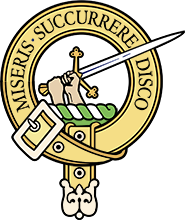Mulligan / Millikin
This name evolved in Dumfries and Galloway from Ap Maolagain (a British/Welsh form of MacMhaolain) through versions such as Amuligain (1482), Amilligane (1575), Mullakane (1645) etc. - see below - to the 18th century Mulligane/Milligan and Milliken/Millikin. The MacMillan link is clearly demonstrated in Perthshire where the form McMhaoiligan appears, and where Mulikyns are to be found on Loch Tayside in the late 15th century occupying lands associated with the MacMillans [William A. Gillies, In Famed Breadalbane, pages 84 & 366-7]. In Galloway and Dumfries too many of the earliest known bearers of the name are recorded in the company of MacMillans, and often living on lands at some time associated with the clan; most notably Arndarroch, which seems to have been the seat of the Galloway MacMillan chieftains in the 16th century, and the Holm of Dalquhairn which is the modern home of their successors: James & Roger Milligane in Arndarroch, and Robert Milligane in Holme of Dalquhairn petitioned against The Book of Common Prayer in 1637 [Register of Privy Council, Vol. 6, 2nd Series, 709-15].
The leading family of the name in the south are recorded as lairds in Nithsdale, Dumfriesshire, from 1505 when Fergus Amuligane of Blakmyr is on record, to 1676 when Joannes Millikin in County Cavan, Ireland, is recognised as the heir of the late Jacobus Millikin of Blackmyre. The Holm of Dalquhairn, which lies at the head of the Water of Ken, was owned in the mid-17th century by the Milligans of Blackmyre; and the places Cormilligan and Strathmilligan are located in and just off the valley of the Shinnell Water, which runs down from a watershed with the Ken to join the Nith not far from the site of Blackmyre near Penpont.
Nearby, a little over half a mile from the smithy at Keir where Kirkpatrick McMillan invented the bicycle, lies a place called Penfillan; and further south near Lag, the seat of the Griersons (in whose papers are to be found many of the earliest references to both M'millans and Milligans in Dumfries and Galloway) lie two places called Milliganton.
The easternmost of these Milligan townships lies next to a place called McCheynston - probably a rendition of "Mac Cain's Town" - while the western Milligantown lies but three miles from the Tower of Brockloch; which may well have been the original seat of the 17th century clan chieftains, the MacMillans of Brockloch (though they are usually associated with the place of the same name in the Glen Kens).
This sits at the height of the road connecting these places in Nithsdale with Ironmacannie, Killochy (seat of the Cannan family in Galloway) and Balmaclellan in the Glen Kens.
A Major James Milliken purchased part of the old barony of Johnstone in Renfrewshire in 1733 and changed its name to Milliken, thus making himself Milliken of Milliken (his coat of arms in the sidebar).
In northern Ireland the connection of many Mulligans with Galloway is acknowledged, and in County Down in particular the name was considered interchangeable with Mullan [Robert Bell, Book of Ulster Surnames, pages 191-2].
